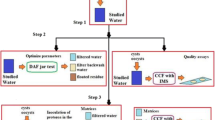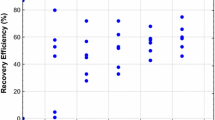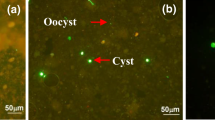Abstract
Immunomagnetic separation (IMS) has been specified as a standard method for the measurement of Giardia under USEPA Method 1623. In this study, IMS was evaluated on the basis of recovery efficiencies for Giardia cysts under various IMS operation conditions. Significant change in recovery was observed by altering the debris ratio of water samples. Notably, cyst recovery efficiencies utilizing IMS dropped with increased turbidity, and results for varying dosages of magnetic beads and cysts indicate that 1 / 100 immunomagnetic beads is sufficient to conjugate large numbers of cysts. Changing vessel volume and replacing the sample buffer had no significant effect on cyst recovery efficiencies.
Similar content being viewed by others
References
Ahmad, R. A., Lee, E., Tan, I. T. L., & Mohamad-Kamel, A. G. (1997). Occurrence of Giardia cysts and Cryptosporidium oocysts in raw and treated water from two water treatment plants in Selangor, Malaysia. Water Research, 31(12), 3132–3136.
Backer, H. (2002). Water disinfection for international and wilderness travelers. Clinical Infectious Diseases, 34(3), 355–364.
Frost, F. J., Craun, G. F., & Calderon, R. L. (1996). Waterborne disease surveillance. Journal of the American Water Works Association, 88(9), 66–75.
Hsu, B. M. (2003). Evaluation of analyzing methods for Giardia and Cryptosporidium in a Taiwan water treatment plant. Journal of Parasitolology, 89(2), 369–371.
Hsu, B. M., Huang, C., Hsu, Y. F., Jiang, G. Y., & Hsu, C. L. L. (2001). Evaluation of two concentration methods for detecting Giardia and Cryptosporidium in water. Water Research, 35(2), 419–424.
Hsu, B. M., Huang, C., Lai, Y. C., Tai, H. S., & Chung, Y. C. (2001). Evaluation of immunomagnetic separation (IMS) method for detection of Giardia at various reaction time and reaction volume. Parasitology Research, 87(6), 472–474.
Hsu, B. M., Wu, N. M., Jang, H. D., Shih, F. C., Wan, M. T., & Kung C. M. (2005). Analysis of Giardia cysts and Cryptosporidium oocysts from source water concentrates using flow cytometry. Environmental Monitoring and Assessment, 104, 155–162.
Lane, S., & Lloyd, D. (2002). Current trends in research into the waterborne parasite Giardia. Critical Reviews in Microbiology, 28(2), 123–147.
Nimri, L. F. (1994). Prevalence of giardiasis among primary-school children. Child Care Health and Development, 20(4), 231–237.
Thompson, S. C. (1994). Giardia-lamblia in children and the child-care setting. Journal of Paediatrics and Child Health, 30(3), 202–209.
USEPA: 1995, ICR protozoan method for detecting Giardia cysts and Cryptosporidium oocysts in water by a fluorescent antibody procedure. Washington, District of Columbia: USEPA Office of Ground Water and Drinking Water.
USEPA (1999). Method 1623: Cryptosporidium and Giardia in water by Filtration/IMS/FA. Washington, District of Columbia: USEPA Office of Water.
Author information
Authors and Affiliations
Corresponding author
Rights and permissions
About this article
Cite this article
Hsu, BM., Huang, C. IMS Method Performance Analyses for Giardia in Water Under Differing Conditions. Environ Monit Assess 131, 129–134 (2007). https://doi.org/10.1007/s10661-006-9462-8
Received:
Accepted:
Published:
Issue Date:
DOI: https://doi.org/10.1007/s10661-006-9462-8




